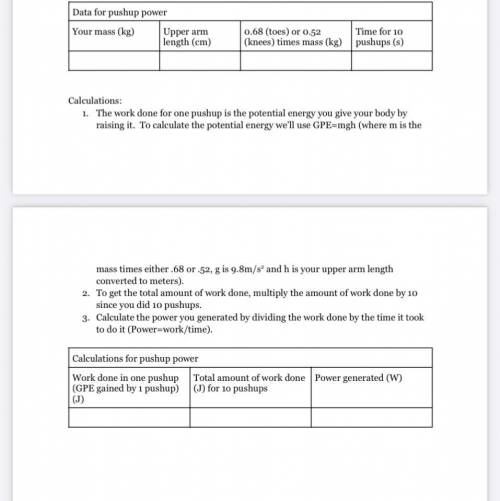Background information:
We know that power is the rate that work is done; what that
really me...

Physics, 30.03.2021 19:00 KKHeffner02
Background information:
We know that power is the rate that work is done; what that
really means is that power tells up how much work is done every
second. To calculate power we just divide the amount of work that
was done by the time it took to do it (Power=work/time). Work is
measured in Joules and time is measured in seconds, we end up with Joules/sec when we calculate power. A Joule/sec is a Watt; we’ll use Watts to measure and compare power.
We also know that the work done on an object is the amount of energy it has gained. For this activity, you’ll be raising your body up as you do pushups which means you’ll be giving your body gravitational potential energy (GPE). To calculate the amount of GPE we multiply mass time gravity times the height raised (GPE=mgh).
What to do (record everything in the table):
1. You need to have a decent estimate of your mass in kilograms: On earth, every
kilogram weighs 2.2 pounds. Either measure your weight on a scale or just
estimate it (in pounds) then divide by 2.2 to get your mass in kilograms.
2. Measure or estimate the length of your upper arm from your elbow to your
shoulder in centimeters...this is how high you raise yourself for every pushup.
3. Decide if you’ll do regular pushups (on your toes) or simpler pushups (knees). If
you are doing regular pushups, multiply your mass by 0.68 because you’ll only be lifting about 68% of your mass each time; if you’re doing simpler pushups, multiply your mass by 0.52 because you’ll only be lifting about 52% of your mass each time.
4. Measure the time it takes for you to do 10 pushups.


Answers: 3


Another question on Physics

Physics, 21.06.2019 15:00
How much work would be needed to raise the payload from the surface of the moon (i.e., x = r) to an altitude of 5r miles above the surface of the moon (i.e., x = 6r)?
Answers: 2

Physics, 21.06.2019 23:50
Select the correct answer from each drop-down menu. compared to its surroundings, the concentration of solutes is low inside a cell. so, the cell is with respect to its surroundings. a particular solute in this cell uses energy for its transport from the cell to its surroundings. this type of transport is called
Answers: 3

Physics, 22.06.2019 05:00
Red light strikes a metal surface and electrons are ejected. if violet light is now used with a 10% greater intensity, what will happen to the ejection rate (number of ejected electrons per second) and the maximum energy of the electrons? a) greater ejection rate; same maximum energyb) same ejection rate; greater maximum energyc) greater ejection rate; greater maximum energyd) same ejection rate; same maximum energye) none of the above answers are correct
Answers: 1

Physics, 22.06.2019 23:40
A2.50 × 105 w motor is used for 26.4 s to pull a boat straight toward shore. how far does the boat move toward shore if a force of 4.20 × 104 n is applied by the motor?
Answers: 2
You know the right answer?
Questions



Mathematics, 07.05.2021 01:00



Mathematics, 07.05.2021 01:00

Mathematics, 07.05.2021 01:00

English, 07.05.2021 01:00

Spanish, 07.05.2021 01:00

Geography, 07.05.2021 01:00

Biology, 07.05.2021 01:00

English, 07.05.2021 01:00


History, 07.05.2021 01:00

Mathematics, 07.05.2021 01:00

Mathematics, 07.05.2021 01:00


Mathematics, 07.05.2021 01:00




